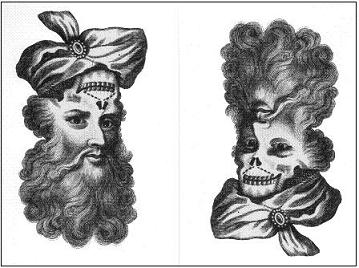- Images with a double meaning
Some images, when turned upside down, would reveal a different subjectmatter, suggesting that things have double faces both literally and figuratively.
The face of a man with a beard and an ornament in the forehead can become a skull when turned upside down, the beard becoming the hair above the skull and the ornament in the forehead becoming the bones in the nose and teeth of the skull. This is a memento mori , a reminder that death lurks under the man's face, a frequent Renaissance theme.

- Anamorphosis
Some forms of Renaissance art, which were known as 'curious perspectives', took varying appearances according to the spectator's successive points of view, thus supposing that the spectator would move around.
A famous example is Holbein's The Ambassadors (1533); see our chapter on 'Anamorphoses'
- Masques
In the 'masques' (allegorical dances at Court in the first half of the 17th century), scene-shifting was spectacular. See our chapter on 'The theatre as a model of space', paragraph on 'Computer modelling of Renaissance theatrical effects '